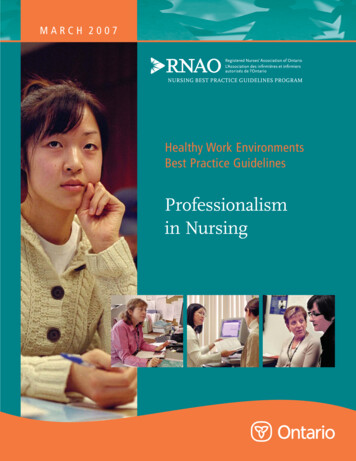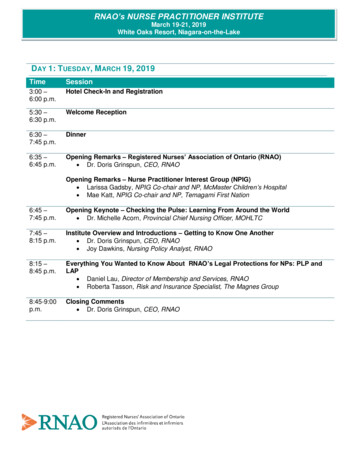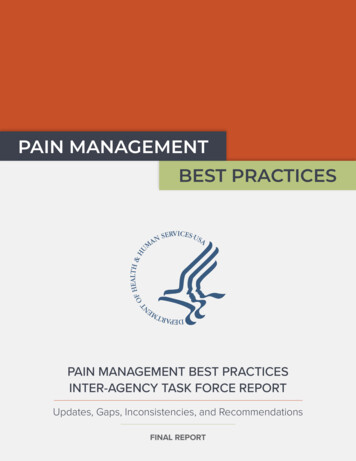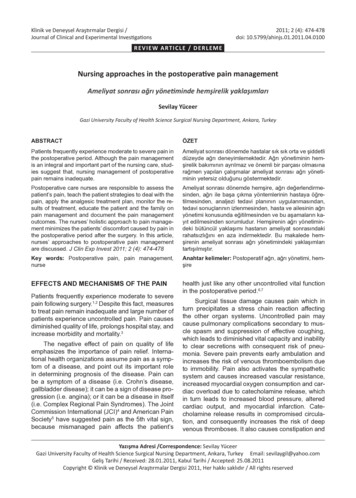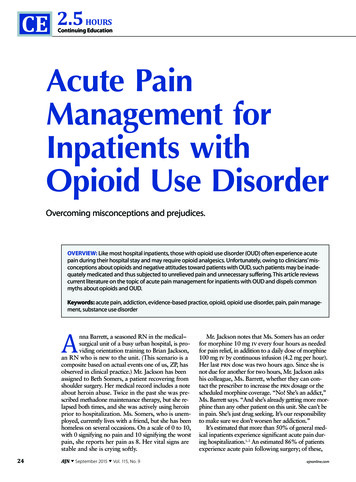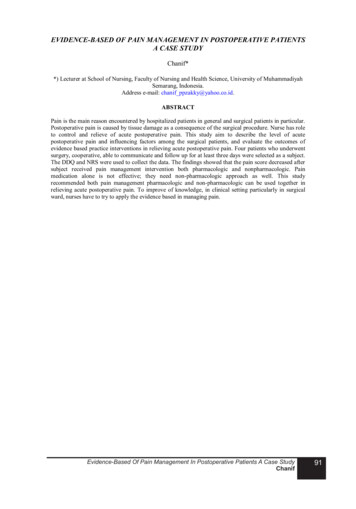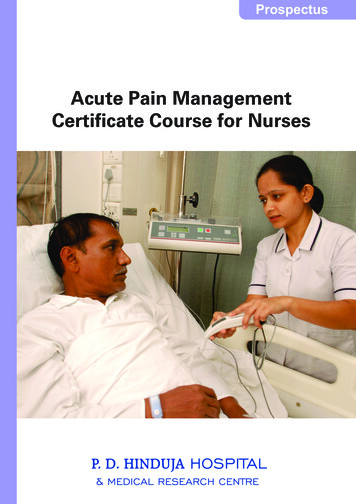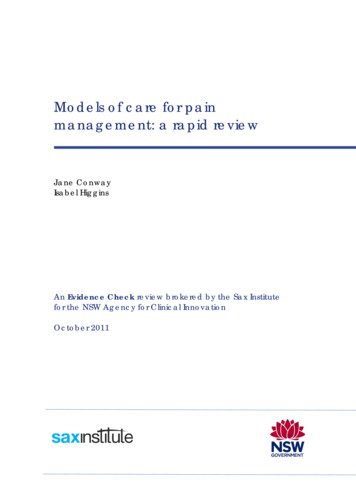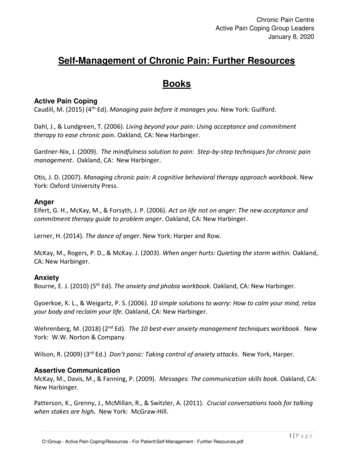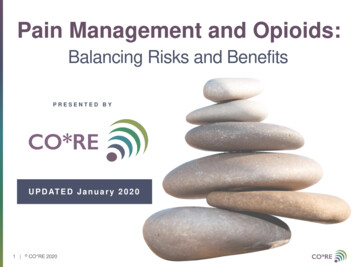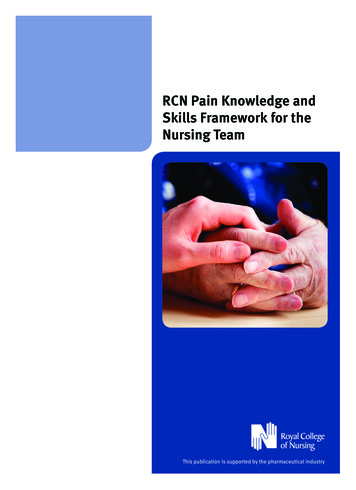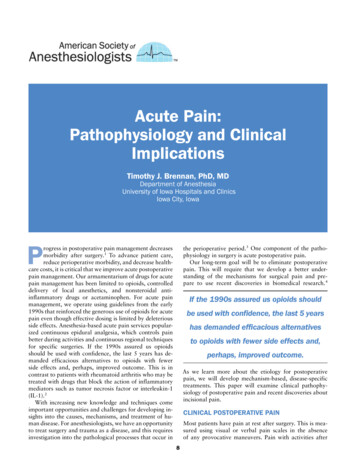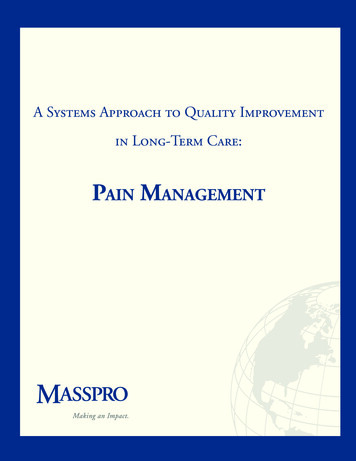
Transcription
A S A Q I L -T C :PAIN MANAGEMENT
A Systems Approach to Quality Improvementin Long-Term Care:Pain ManagementTable of ContentsIntroductionTab 1Organizational Commitment to Pain ManagementTab 2Pain Management PoliciesTab 3Educating StaffTab 4Screening, Assessing and Monitoring PainTab 5Treatment and Clinical Tools for Pain ManagementTab 6Care Planning for PainTab 7Educating Residents and FamiliesTab 8Identifying and Reporting Pain: A Facility-Wide ResponsibilityTab 9Regulations and Resources Related to PainTab 10ReferencesThis material was prepared by Masspro, the Medicare Quality Improvement Organization for Massachusetts, under contract with the Centers for Medicare & Medicaid Services (CMS),an agency of the U.S. Department of Health and Human Services. The contents presented do not necessarily represent CMS policy. 8sow-ma-nhqi-06-72 PainToolkit-nov-CDA Systems Approach to Quality Improvement in Long-Term Care:Pain ManagementPage
IntroductionAcknowledgementsTermsMasspro wishes to thank the following for their contribution in compiling information for this workbook:Masspro – Massachusetts Peer Review Organization, Inc.,the healthcare Quality Improvement Organization (QIO)for Massachusetts. Rhode Island Quality Partners, the QualityImprovement Organization Support Center (QIOSC)for the Centers for Medicare & Medicaid Services(CMS) Nursing Home Quality Initiative (NHQI)The University of Wisconsin-MadisonInstitutionalizing Pain Management Project(References from Building an InstitutionalCommitment to Pain Management - The WisconsinResource Manual 2nd Edition, 2000) Juliet Connelly, RN, for her assistance in thepreparation of these materials. Additional content has been provided byCarol P. Curtiss, MSN, RN, CDisclaimerQIO – (Quality Improvement Organization) The namefor the organizations across the United States working toimprove quality of care in various healthcare settings.CMS – Centers for Medicare & Medicaid Services, anagency of the U.S. Department of Health and HumanServicesNHQI – (Nursing Home Quality Initiative) The CMSinitiative on improving nursing home quality of care. Includes the public reporting of 10 quality measures andwork done in partnership with QIOs across the countryon improvement projects.MedQIC – (www.medqic.org) CMS developed this comprehensive online resource of quality improvement information for Medicare’s National Quality ImprovementPriority Topics.Masspro stresses that medical knowledge and pharmacologic options for pain management are constantly changing. Information found in this workbook is intended asgeneral information only. This workbook should be usedas a guide for implementing processes and all medical/pharmacologic references would need verification for current appropriateness.This material was prepared by Masspro under contractwith the Centers for Medicare & Medicaid Services(CMS). The contents presented do not necessarily reflectCMS policy.A Systems Approach to Quality Improvement in Long-Term Care:Pain ManagementPage
IntroductionA Systems Approach to Quality Improvement in Long-Term Care:Pain ManagementIntroductionThe goal of this workbook is to give long-term care healthproviders throughout Massachusetts the information andresources they need to improve systems essential for managing pain for residents. The workbook should also assistlong-term care facilities in advancing the quality of painmanagement services and clinical outcomes for residentsreceiving those services and provide information to assistfacilities with JCAHO (Joint Commission on Accreditation of Healthcare Organizations) evaluations of pain care.This workbook is based upon material developed for theCenters for Medicare & Medicaid Services (CMS) Nursing Home Quality Initiative (NHQI) and informationobtained from multiple sources and guidelines related topain management. Recommendations from the AmericanGeriatrics Society (AGS), the American Medical DirectorsAssociation (AMDA), the American Pain Society (APS),the University of Wisconsin-Madison, Institutionalizing Pain Management Project, and others are referencedthroughout this manual.NeedPain is the most common reason individuals seek medicalattention. According to the American Pain Society (APS),50 million Americans are partially or totally disabled bypain, and 45% of all Americans seek care for persistentpain at some point in their lives. Pain is the most commonreason individuals seek healthcare.There are no biological markers of pain. Therefore, themost accurate evidence of pain and its intensity is basedon the patient’s self report (Turk and Melzack; 1992, APS2003). A simpler definition might be that pain is “whatever the person says it is, existing whenever he/she says itdoes” (McCaffery 1999; Teno et al.).Pain may include a range of physiological, emotional andsensory symptoms, such as aching, throbbing, burning,numbness, squeezing, pressure, cramping, and tightness. These sensations may vary in severity, persistence,source, and management. In the long-term care setting,pain prevalence can be as high as 85% (Stein; et al. 1996).According to the AGS Panel on Chronic Pain in OlderPersons (1998, 2002), chronic pain in the long-term caresetting is generally under-recognized and under-treated.Assessment and treatment of pain are basic rights for allresidents. Working towards the goal of competent paincare for residents in nursing facilities starts with an administrative commitment to improve pain assessmentand management and provide policies, procedures, andsupport for staff. Components of clinical practice includeoutlining the processes necessary for understanding andrecognizing pain, routinely screening all residents forpain, assessing pain, planning care to manage pain, andongoing monitoring of the pain plan. A cycle occurs thatinvolves continuous analysis of the individual resident’spain management needs and outcomes. Evaluating outcome measures can reflect overall success of the facility’spain management program.What is pain? The International Association for the Studyof Pain gives this definition, “an unpleasant sensory andemotional experience, associated with actual or potentialtissue damage or described in terms of such damage.”(Merskey and Bogduk 1994; APS 2003).A Systems Approach to Quality Improvement in Long-Term Care:Pain ManagementPage
IntroductionMasspro’s Nursing Home QualityInitiativeMasspro staff and project partners have been workingsince 2002 to improve pain assessment and managementin long-term care facilities in Massachusetts through theNHQI. Efforts include:Information CampaignSince the fall of 2002, Masspro staff and project partners have educated long-term care facilities (LTCF)about the CMS NHQI and the public reporting of10 quality measures. Information and resource sharing will continue to be provided to providers and thepublic.Pain WorkbookDistribution of this pain workbook, “A Systems Approach to Quality Improvement in Long-Term Care:Pain Management” to Massachusetts LTCFs.Educational Workshops and ConsultationMasspro presents workshops on pain management andconsultation for LTCFs throughout the state.your facility’s needs, improvement is continuous and caninvolve both new development of practices as well as revisions of current practices.Major Areas of FocusTab 1Organizational Commitment to PainManagementTab 2Pain Management PoliciesTab 3Educating StaffTab 4Screening, Assessing and Monitoring PainTab 5Treatment and Clinical Tools for PainManagementTab 6Care Planning for PainTab 7Educating Residents and FamiliesTab 8Identifying and Reporting Pain: A Facility-WideResponsibilityTab 9Regulations and Resources Related to PainManagementContributions to www.medqic.orgMasspro has contributed education materials andresources to the MedQIC website.Tab 10 ReferencesNote:How to Use This Resource ManualThis pain management workbook is designed to outline aprocess that leads to improvement in managing pain. Eachtabbed section has an explanation of the material foundwithin each tab. Tools that apply to the particular sectionare listed as well as actions, key points, and reminders thatassist you in moving through the various tabs.For ease of reading, we used the term “residents”throughout this workbook. All materials apply to longterm care residents and short-stay patients.Though the tabs may be thought of as “steps,” you mayfind your facility has worked on all or some of the areas or may be at the beginning stages of forming a painmanagement program. No matter where you determineA Systems Approach to Quality Improvement in Long-Term Care:Pain ManagementPage
Tab 1: Organizational Commitment to Pain ManagementCommitment of OrganizationMany factors make pain assessment and management inthe long-term care setting challenging. Organizationalcommitment, also referred to as institutional commitment, is essential to overcoming these barriers. Theleadership of the organization must ensure that a commitment to resident comfort permeates all aspects of thefacility’s operation. The Agency for Healthcare Researchand Quality (AHRQ), American Pain Society (APS), andthe Joint Commission on Accreditation of Healthcare Organizations (JCAHO) emphasize the need for: Establishment of a formalized approach to painmanagement Agency standards for collaborative andinterdisciplinary approaches Policies and procedures that guide appropriatepractice Individualized pain control plans Routine screening, assessment, and frequentreassessment Both pharmacological and non-pharmacologicalstrategies to alleviate painThis system-wide interdisciplinary approach has becomeknown as “institutionalizing pain management.” Thisprocess focuses on identifying and breaking down systembarriers to effective pain management, while using severalmethods to incorporate the basic principles of pain management into patterns of daily practice.Actions: Commit your organization to improving painassessment and management for all residents. Assess pain management practices and policies.Compare them to nationally published standardsand guidelines. Identify improvement areas– Develop a plan for improvement– Pilot the plan in one area of the facilityIn This Section:Recognition of Pain in LTCAddresses building a facility-wide, “top leadership down” commitment to managing pain.Pain Management: Essential Systems forQuality CareThis tool is designed to help you identify areasof focus for systems review. It provides keyinterventions for the area being reviewed andallows you to identify where actions are needed.Flow Diagram: Organization Commitmentto Pain ManagementThis diagram addresses logical steps and keyelements that explain a system-wide approach tomanaging pain.Checklist: Evaluate Key Steps forOrganizational SystemThis checklist focuses on the initial process stepsnecessary in developing a pain managementprogram. This checklist links to other checklistsin following tabs.Action PlanUse this form to help plan your improvementsteps.Quality Improvement Monitoring of PainManagement ProcessQuality Improvement Monitoring of PainManagement for ResidentKey Point:Identifying current practice and determining strengthsand weaknesses is pivotal in planning improvementactivities.– Evaluate the plan and make necessary changes– Roll out the plan facility-wide– Evaluate improvementA Systems Approach to Quality Improvement in Long-Term Care:Pain ManagementPage
Organizational Commitment to Pain ManagementRecognition of Pain in Long-Term CareRecognizing PainCognitive and Communication BarriersPain is under-recognized for many of the same reasonsthat the early signs and symptoms of many other conditions, such as depression, congestive heart failure, andadverse effects of medications are under-recognized in thelong-term care setting. The clinical practice guidelinesfor “Chronic Management in the Long-Term Care Setting” from the American Medical Directors Association(AMDA), identifies some of the following barriers regarding the recognition of chronic pain in the long-term caresetting.Cognitive impairment, delirium (common among theacutely ill elderly), and dementia which occurs in as manyas 50% of the institutionalized elderly, pose serious barriers to pain assessment. Residents may be unable to reportfeeling pain or to respond to caregivers’ questions aboutpain due to cognitive or sensory impairments, or becauseof difficulties with language or speech. Direct care staffor supervisors may fail to recognize the behaviors or language (of cognitively impaired residents) that suggest thepresence of pain.Cultural and Social BarriersBarriersSystem BarriersPain is often overlooked and is a low priority for manyfacilities. High turnover of direct caregivers, inadequatelyfunctioning care teams, insufficient commitment to painmanagement by leadership in long-term care facilities,and the highly regulated nature of the long-term care setting may result in a system that fails to give priority to therecognition, assessment, and treatment of pain. Other factors may include inappropriate nurse/resident ratios, physician reluctance to use opioids for non-malignant pain,the lack of staff knowledge or appropriate tools, and thefear of regulatory scrutiny.Co-Existing Illnesses, Multiple Diagnoses, andMultiple Medication Use BarriersIllness such as depression, multiple diagnoses such asdegenerative joint disease, diabetes, cancer (occurring atthe same time), as well as multiple medication use, mayreduce residents’ ability to interpret or report pain. Theuse of multiple medications may also modify response topain, hindering staff ability to recognize that a resident isin pain.Racial, ethnic, and gender biases held by both residentsand caregivers may hinder residents from reporting painand may reduce caregivers’ sensitivity to the signs andsymptoms of pain. Strongly held religious beliefs mayprevent residents from acknowledging pain or acceptingtreatment for pain.Atypical PresentationEl
ongoing monitoring of the pain plan. A cycle occurs that involves continuous analysis of the individual resident’s pain management needs and outcomes. Evaluating out-come measures can reflect overall success of the facility’s pain management program. Page 4 Introduction A Systems Approach to Quality Improvement in Long-Term Care: Pain Management Masspro’s Nursing Home Quality Initiative .
